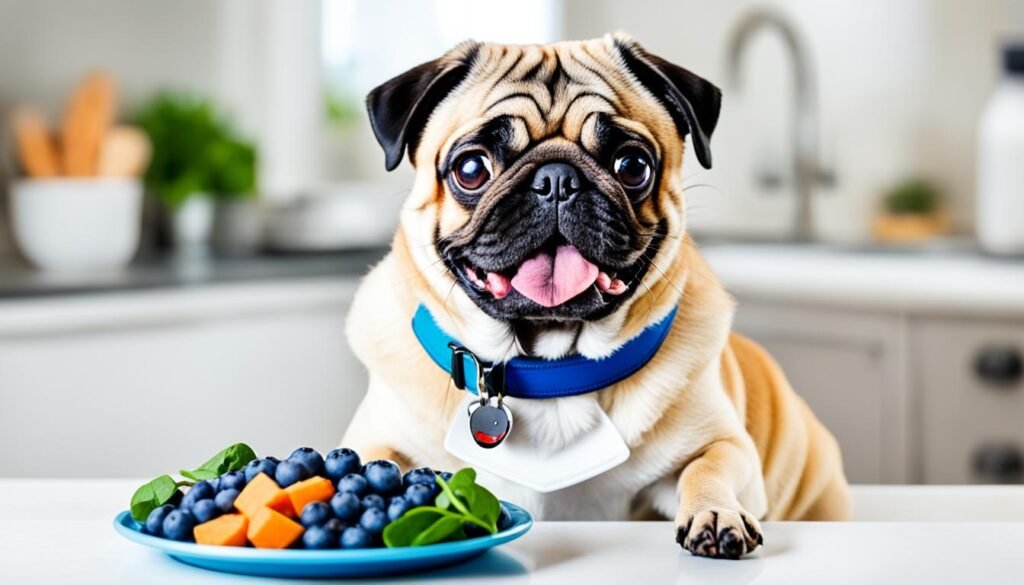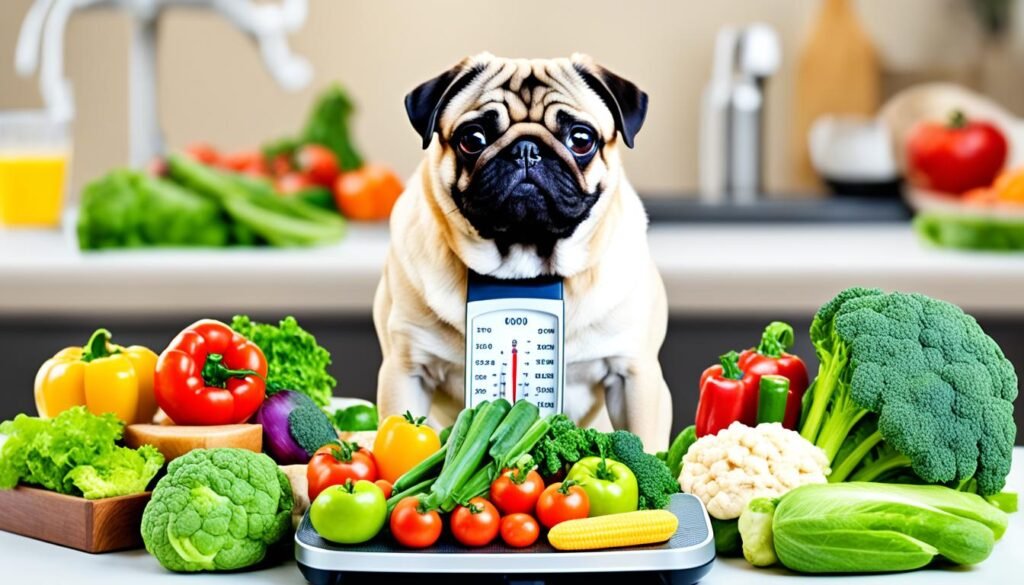The best and worst foods for Pugs
Pugs are loved for their sweet and playful nature. As a caring pet owner, it’s key to focus on their diet. A balanced diet is crucial for their health, weight, and avoiding health problems.
This article will cover the best and worst foods for Pugs. It gives you important tips on what they need to eat. Whether you’re new to pugs or want to learn more, this guide will help you make good choices for your Pug’s health.
Let’s start by looking at foods that are good and bad for your Pug. We’ll see which foods are safe and which ones to avoid to keep your Pug healthy.
It’s important to know what foods are best for Pugs to keep them happy and healthy. By choosing wisely and avoiding bad foods, you can give your Pug a diet that meets their special needs.
Foods that Pugs Can Safely Consume

Pugs can eat many foods that are good for them. These foods help keep them healthy and happy.
Lean meats like chicken and turkey are great for pugs. They give pugs the amino acids they need. Make sure to take out any bones and skin first.
Vegetables are also good for pugs. Carrots and green beans are perfect because they’re low in calories and high in fiber. They help with digestion and clean pugs’ teeth naturally.
Sweet potatoes are another good choice. They have vitamins A and C, which boost the immune system and help with digestion. You can cook, mash, or give them as dry treats.
Small amounts of cooked rice or pasta are okay for pugs. But don’t give them too much. This can lead to too many calories and weight gain.
For treats, choose ones made for pugs’ diets. They should be low in fat and without harmful additives. Treats should only be 5% of their daily food.
Adding safe foods to a pug’s diet helps their health and makes meals fun. Always talk to your vet to make sure your pug’s diet is right for them.
Foods that Pugs Should Avoid

Pugs love to eat, but some foods are bad for them. They can get sick from eating certain things. Here are foods you should not give to your pug:
- Chocolate: toxic foods for pugs – Chocolate has theobromine, which is bad for dogs. It can make them vomit, have diarrhea, breathe fast, and their heart beats too fast. It can cause seizures and even death.
- Onions and Garlic: foods harmful to pugs – Onions and garlic can hurt a dog’s red blood cells, causing anemia. Pugs get very sick from this, so don’t give them foods with these in them.
- Grapes and Raisins: toxic foods for pugs – Grapes and raisins can make dogs’ kidneys fail. This is very dangerous. Even a little bit can be very bad, so keep these fruits away from your pug.
- Alcohol: toxic foods for pugs – Alcohol is much worse for dogs than for people. It can make them vomit, move funny, and even stop breathing. Make sure your pug can’t get to alcohol.
- Caffeine: toxic foods for pugs – Caffeine makes dogs very nervous. It can make them shake, breathe fast, and even have seizures. Don’t give your pug coffee, tea, energy drinks, or chocolate.
- Foods high in fat or salt: pugs and obesity – Pugs can easily get too fat, which is bad for their health. Foods with a lot of fat or salt make them gain weight and hurt their heart and joints.
Watch your pug and look for any signs they don’t like certain foods. Pugs can also be allergic to some foods. Try new foods slowly and watch how they react. If you’re worried about your pug’s diet, talk to a vet for advice.
Managing Pug Weight and Preventing Obesity

Pugs are cute pets but can easily gain weight. It’s important to manage their diet and exercise. This keeps them healthy and happy.
Feeding the right amount is key. Give your pug high-quality food in the right amounts. Talk to your vet to find out how much your pug needs based on their age and activity level. Feeding too much can lead to weight gain.
Also, watch how many treats you give. Treats are tempting but should be rare. Choose healthy treats or use their regular food as a reward. This helps keep their calorie intake in check.
Exercise is also vital. Pugs need to move to stay fit. Try daily walks, playtime, or agility training. Exercise helps with weight control and keeps your pug’s mind sharp.
Preventing obesity is crucial. Control their food, exercise them regularly, and watch their weight. This keeps your pug healthy and happy for years.
Special Dietary Considerations for Pugs
If you own a pug, you might know they have special diet needs. These needs are key to keeping your pug healthy and happy. Let’s look at these special needs and how to meet them.
Allergies and Sensitivities
Pugs can be allergic to things like grains or dairy. These allergies can cause stomach problems and skin issues. To help your pug, find out what they’re allergic to and remove it from their food. Giving them a diet without allergens can ease their discomfort and improve their health.
Pug-Sensitive Stomach
A pug’s stomach is sensitive, so it’s important to feed them foods that are easy to digest. Don’t change their diet suddenly. Instead, switch foods slowly to help their stomach adjust. This can prevent stomach problems.
Pug-Skin Allergies
Pugs often get skin allergies that make them itch, get red, and get irritated. Eating foods rich in omega-3 fatty acids, like fish or flaxseed oil, can help. Also, using hypoallergenic ingredients in their meals can lower the chance of allergic reactions.
Talking to a vet is key in making a diet plan for your pug. They can give advice based on their knowledge. This can help you handle any diet challenges for your pug.
The Importance of Commercial Dog Food
Commercial dog food is crucial for your pug’s health. It’s made just for their needs. This food gives them the right nutrients for good health.
Choosing the right dog food for pugs has many benefits. It meets their unique needs, including their metabolism and health concerns. This ensures they get all the vitamins and nutrients they need.
When picking dog food for your pug, go for trusted brands. Look for foods made just for pugs. They should use real ingredients and avoid fillers and artificial stuff.
Commercial dog food is also easy and consistent. It comes in handy packaging, making feeding time simple. It also gives your pug a steady, balanced diet. This means you don’t have to spend a lot of time planning meals or looking up recipes.
Conclusion: Keeping Your Pug Healthy and Happy
Feeding your pug right is key to their health and happiness. Give them a balanced diet to keep them lively. Make sure to keep them away from harmful foods.
It’s also vital to watch their weight. Too much weight can harm their health. So, control their food and make sure they exercise often.
Some pugs might need special diets because of allergies or health issues. Talking to your vet can help figure out what’s best for them.
By focusing on good nutrition and care, you and your pug can have a great life together. Their health and happiness rely on how well you take care of them. So, enjoy the journey of keeping your pug happy and healthy, and make every moment special.

